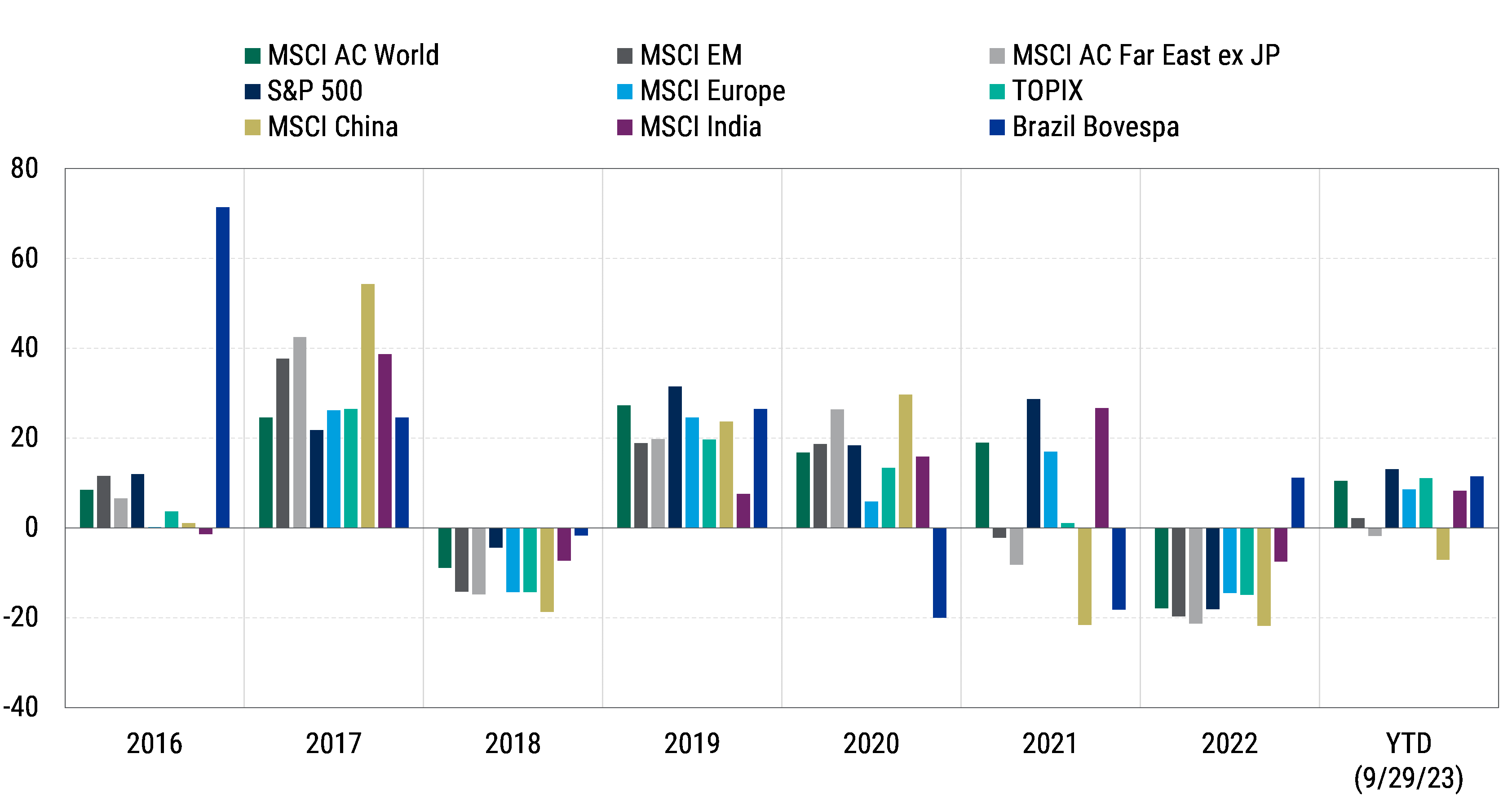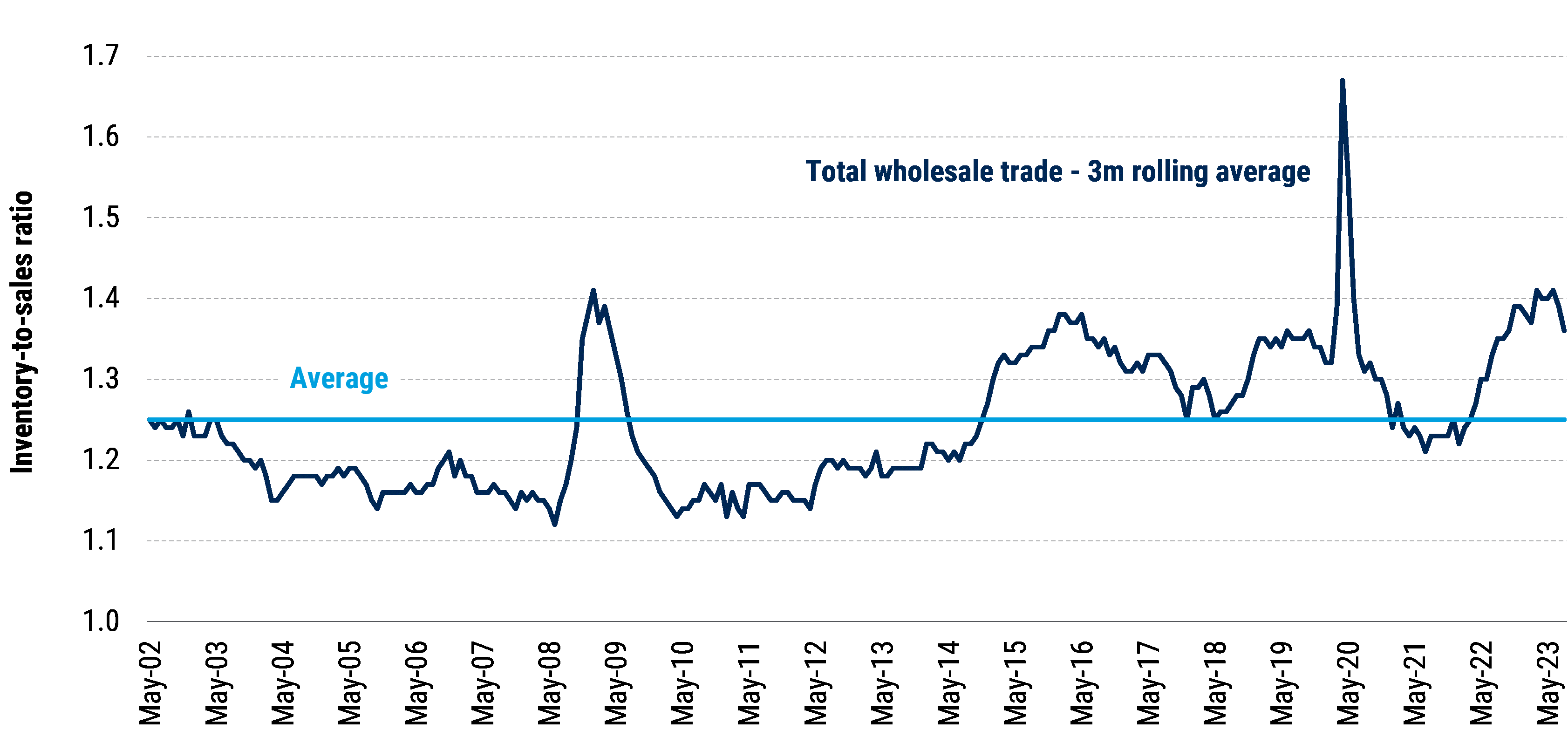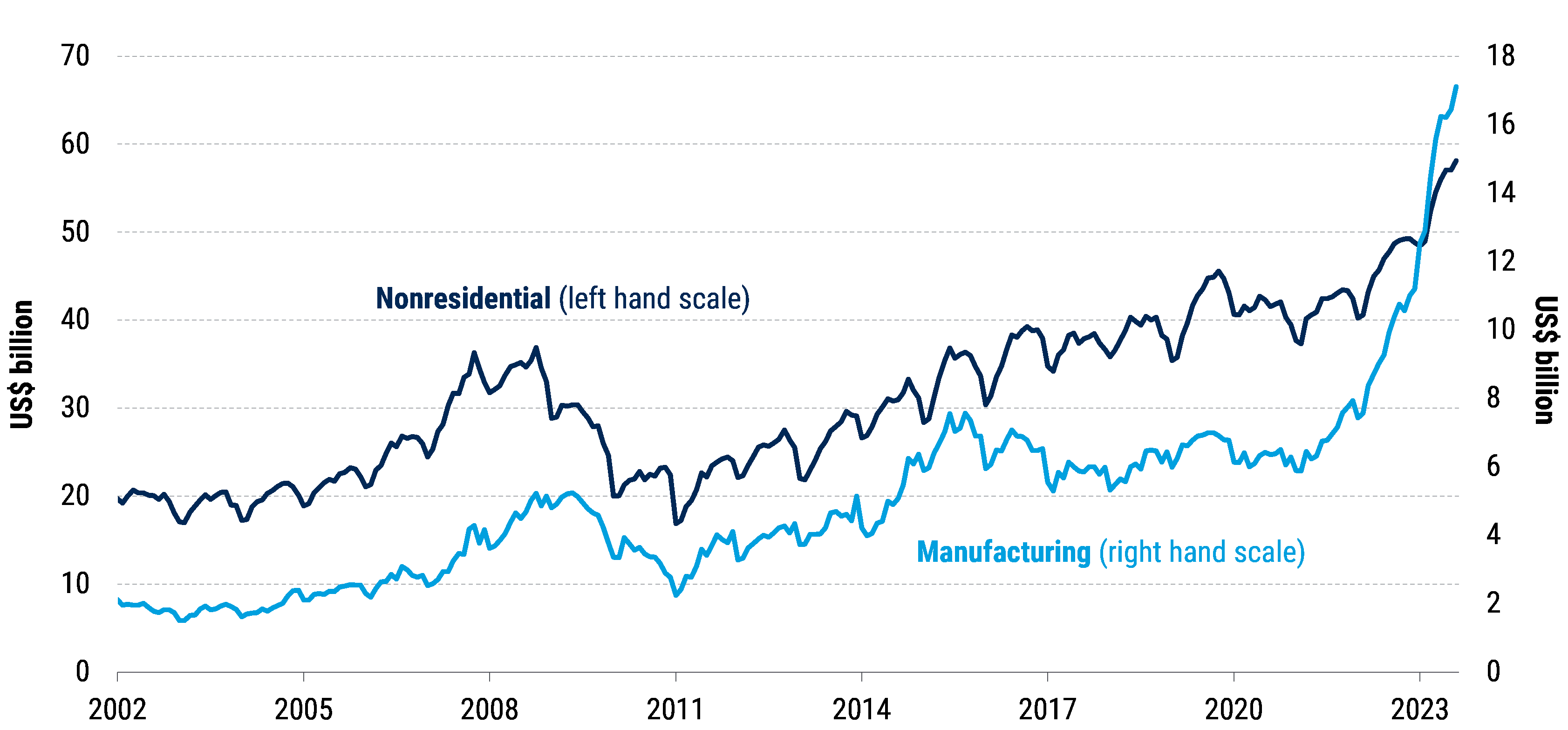Select your geography
Americas
2024 Equity Outlook: Investing When Cycles Are Out of Sync

Rob Hinchliffe, CFA
Portfolio Manager, Head of Global Sector Cluster Research

Kenneth Ruskin, CFA
Director of Research and Head of Sustainable Investing – Global Equities
The era for synchronized global growth, when China could be counted on for outsized expansion that provided a broad cross-border lift for economies, industries, and asset classes, is giving way to a new regime in which growth cycles vary significantly across regions.
Given the wide dispersion in growth cycles, the old playbook of buying stocks when companies slash earnings estimates and selling them when earnings hit cyclical peaks can’t be applied worldwide – highlighting the importance of actively investing wherever the best-positioned companies are found.
Different sectors are experiencing rolling de-stocking periods, making it difficult to pinpoint true end-demand and underscoring the importance of both on-the-ground local insights and company-specific fundamental analysis.
The longer-term themes of capex related to near-shoring, net-zero funding, and green energy can benefit active investors regardless of cycle. These trends may boost US-focused manufacturers as well as banks and consumer product companies in countries such as India and Mexico, along with automation equipment companies. Green energy momentum is a tailwind for heating and air conditioning product makers, mining equipment manufacturers, rail and rail equipment providers, and electric vehicle battery manufacturers.

It’s the end of an era for synchronized global growth, when China could be counted on for outsized expansion that provided a broad cross-border lift for economies, industries, and asset classes. The old regime is giving way to a new one in which growth cycles vary significantly across regions (see chart). Underneath these dynamics lie further divergences between different industries, driven in large part by significant variations in post-Covid inventory trends across end-markets.
Global Stock Markets and Economies Are No Longer Moving in Step
Total Gross Return (%)

Source: FactSet as of 29 September 2023.
That said, certain more evergreen themes – including corporate spending on near-shoring and green energy – are creating opportunities regardless of the cycle. In fact, the increased volatility arising from desynchronized growth presents even more opportunities for active managers to find stocks that benefit from these longer-term themes at attractive prices. While synchronized growth can be more favorable to passive investing, given that returns tend to be correlated across regions and industries, desynchronized growth should favor active investing in the year ahead.
Here we share our key convictions for global equity investing in 2024.
Key Convictions
1. Given the wide dispersion in growth cycles globally, the old playbook of buying stocks when companies slash earnings estimates and selling them when earnings hit cyclical peaks can’t be applied worldwide – highlighting the importance of actively investing wherever the best-positioned companies are found.
Widely divergent economic cycles are playing out across regions, with China seemingly at a trough in terms of industrial and consumer activity, while in the US, industries that benefited from the fiscal stimulus and tight supply chains during Covid appear to be peaking. The typical “playbook” for investors in cyclical stocks is to buy when economic activity is at a low and earnings estimates have been cut. This means that, counterintuitively, cyclical stocks typically should be bought when valuations on near-term earnings look expensive. In prior years, synchronized growth allowed this playbook to be applied across the globe. Now, we see an opportunity to apply this approach in China, which appears to be experiencing a “typical” cyclical trough. But the situation is quite different for many cyclicals in the US – specifically industrial companies that have benefited from supply chain tightness – where earnings and margins appear to be peaking despite weak macro data, such as purchasing managers’ indices (PMIs). Active managers are well positioned to navigate these different cycles and to find attractive equity alpha opportunities.
2. Different sectors are experiencing rolling de-stocking periods, underscoring the need for on-the-ground regional insights into industries paired with fundamental analysis of companies.
Desynchronized growth is not just evident regionally, but also within regions when we look at individual sectors. The need to unload inventory amid swollen backlogs – a Covid hangover for many companies – started with the semiconductor industry and has since rolled into consumer goods, medical equipment, transportation, and logistics, along with industries that feed into housing. Inventory-to-sales ratios have come down significantly in some sectors, indicating resolution of these issues; for others, such as automation and general industrial companies, including electricals, machinery, and miscellaneous durables, the de-stocking phase has yet to begin (see chart below).
Inventory-to-Sales Ratios Are Still Rising for Many Companies
US wholesale trade inventory-to-sales ratio (2002-2023)

Source: Citi Research and US Census Bureau as of 18 October 2023.
Higher interest rates are exacerbating this divergence because they hit certain industries harder than others, including housing; big-ticket purchases that are typically financed, such as cars and furniture; and some inventory-heavy industries, such as distributors. Looking into 2024, we expect de-stocking in some industries underlying the wholesale trade chart to lead to lower-than-usual orders and sales for these companies, and the general availability of inventory could also put pressure on prices and margins. Many of these companies benefited from strong pricing during the Covid-induced supply chain issues: If a company could produce a part, it could usually name its price, as customers needed it as soon as possible. Resolving supply chain issues could therefore be a mixed blessing for these companies in 2024. Rolling de-stocking has made it difficult to pinpoint true end-demand and highlights the importance of both local insights and company-specific analysis.
3. Capex related to near-shoring, net-zero funding, and green energy is a longer-term theme that can benefit active investors regardless of cycle.
The push for companies to bring operations closer – both to home and to end consumers – has resulted in a surge in US manufacturing spending since the pandemic, as shown in the chart below. The upswell has been driven largely by the technology sector, including semiconductors (with momentum from the CHIPS Act) and other components, as well as finished devices, with artificial intelligence expected to become an ever-larger contributor. Indeed, spending on computer, electronic, and electrical manufacturing has more than doubled in the past year.1 Beneficiaries of the near-shoring trend include US-focused manufacturers as well as banks and consumer product companies in countries such as India and Mexico that are benefiting from supply chain shifts. Automation equipment companies in particular enable near-shoring by reducing labor content in products, and are therefore a key beneficiary of this trend. Momentum behind green energy and net-zero spending is also ramping up, giving a boost to companies that help clients meet carbon-reduction goals. These include heating and air conditioning product makers, mining equipment manufacturers, rail and rail equipment providers, and electric vehicle battery manufacturers.
Near-Shoring, Especially in Tech, Has Driven US Manufacturing Capex
US construction spending (in private sector): nonresidential total and manufacturing-related spending

Source: US Census Bureau as of 20 October 2023.
Though we may be seeing the end, at least for now, of synchronized global growth, the resulting volatility creates an investment landscape ripe with alpha opportunities. The key is combining on-the-ground insights into local industries with strong fundamental analysis, with an eye to finding the best-positioned companies – both within the current cycle and relative to longer-term (and cycle-agnostic) trends.
For more investing insights, access our 2024 Global Investment Outlook.
1Source: U.S. Census Bureau, Construction Spending, 2 October 2023.
Disclosure
Investing involves risk, including possible loss of principal. The information presented herein is for illustrative purposes only and should not be considered reflective of any particular security, strategy, or investment product. It represents a general assessment of the markets at a specific time and is not a guarantee of future performance results or market movement. This material does not constitute investment, financial, legal, tax, or other advice; investment research or a product of any research department; an offer to sell, or the solicitation of an offer to purchase any security or interest in a fund; or a recommendation for any investment product or strategy. PineBridge Investments is not soliciting or recommending any action based on information in this document. Any opinions, projections, or forward-looking statements expressed herein are solely those of the author, may differ from the views or opinions expressed by other areas of PineBridge Investments, and are only for general informational purposes as of the date indicated. Views may be based on third-party data that has not been independently verified. PineBridge Investments does not approve of or endorse any republication of this material. You are solely responsible for deciding whether any investment product or strategy is appropriate for you based upon your investment goals, financial situation and tolerance for risk.



